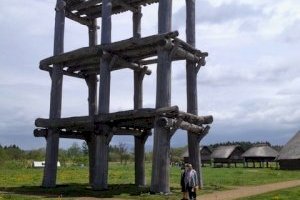
I played in May 2014 a concert in the big modern concert hall of Hachinohe. During my stay in that city for rehearsals I had plenty of spare time and there seemed very little to see in this modern town. Public transport was only marked with Japanese letters, hardly anybody spoke any English, I felt rather trapped. Unfortunately I did not know about the Korekawa Jomon Site and missed out on that. I am not sure if it existed at that time or not. But after the concert I travelled west with my hosts to Aomori city to the same site that Els has visited, Sannai-Maruyama.
This is a big modern museum complex: The outside area is impressive with several "reconstructed" buildings. At the few places where you can see original digs you see not much more the holes for pillars. Therefore there must be a lot of experienced guessing work involved in those reconstructions.
The finds inside the museum are much more 'real'. In my memory the biggest part consisted of pottery. Their pottery seems to be one of the earliest in the world and their artifacts are often very creative. This raises the questions if a people can or should be inscribed for their pottery, meaning for moveable objects. If that were true then the Mexican Olmec culture, which is a bit younger but has even more impressive artifacts including the giant head sculptures should certainly be included as well. Very close to this Museum is a big museum with modern art worth a look in my opinion.
The Jomon are still a rather mysterious people but important in many aspects beyond their art of pottery: They were the first known people to populate Japan and this happened surprisingly late around 13,000, long after humans had spread over Australia and even after the Americas. They are supposedly not related to the current Japanese Yamato people who arrived much later from mainland Asia and possibly repressed the previous, older population, consisting possibly of the descendants of the Jomon. Hardly anything is known about that.
On the other hand in the north of Honshu, the main island of Japan, and on the northern island of Hokkaido you find still the one of the two old remaining minorities of Japan, the Ainu. Genetical studies show that they have much stronger ties to the Jomon people. This research is rather recent and still ongoing partly because the Ainus were long repressed as as dominating Yamato people spread the myth that Japan was a homogenous people. The same myth of national unity is spread by the Chinese Han and many other nations to strengthen their legitimacy and to suppress minorities.
After the Jomon period followed several shorter periods including the Kofun period with its respective WHS. During the Asuka period in the 7th century Prince Shotoku introduced, as legend tells, Buddhism into Japan. This period is BTW represented on the tentativ list and a very interesting visit, easily linked with the impressive Horyu ji temple. All periods before the introduction of Buddhism had no writing that we know of. Even the famous Prince is semi legendary and while there is a long line of Japanese Emperors going back thousands of years and to the sun goddess all emperors before Asuka are semi or even completely legendary. Many Kofuns are also linked to Emperors and Empresses but there is very little archeological evidence to any of those links. I think this is really rather striking how much of their history is legendary or semilegendary and how sharp a cut appears around the 7th century with the use of writing.
This means that we know almost nothing about language, rites, social structure of the Jomon but there are theories the many Japanese customs today are still going back to Jomon rites: Among them the animistic Shinto cult that is today still as omnipresent in Japan as Buddhism. Often both cults are also mixed though theoretically they are separate but most Japanese make sure they get help from both pantheons. A lot of those Jomon influences will always remain a theory but who knows how much new knowledge genetics and other new fields of research will reveal.
While the Jomon are incredibly important for south east asian history and an interesting and enigmatic people this remains a problematic WHS because there are very scant remains in situ and their most interesting heritage are their artifacts. So it is certainly worth visiting one or two of the best sites but it may be hardly worth visiting all sites. Maybe this WHS would be almost better served had they just chosen the few couple of sites but it seems to be the tendency nowadays that not the best example of a culture gets inscribed pars pro toto but as many sites as possible get included.
Comments
No comments yet.
